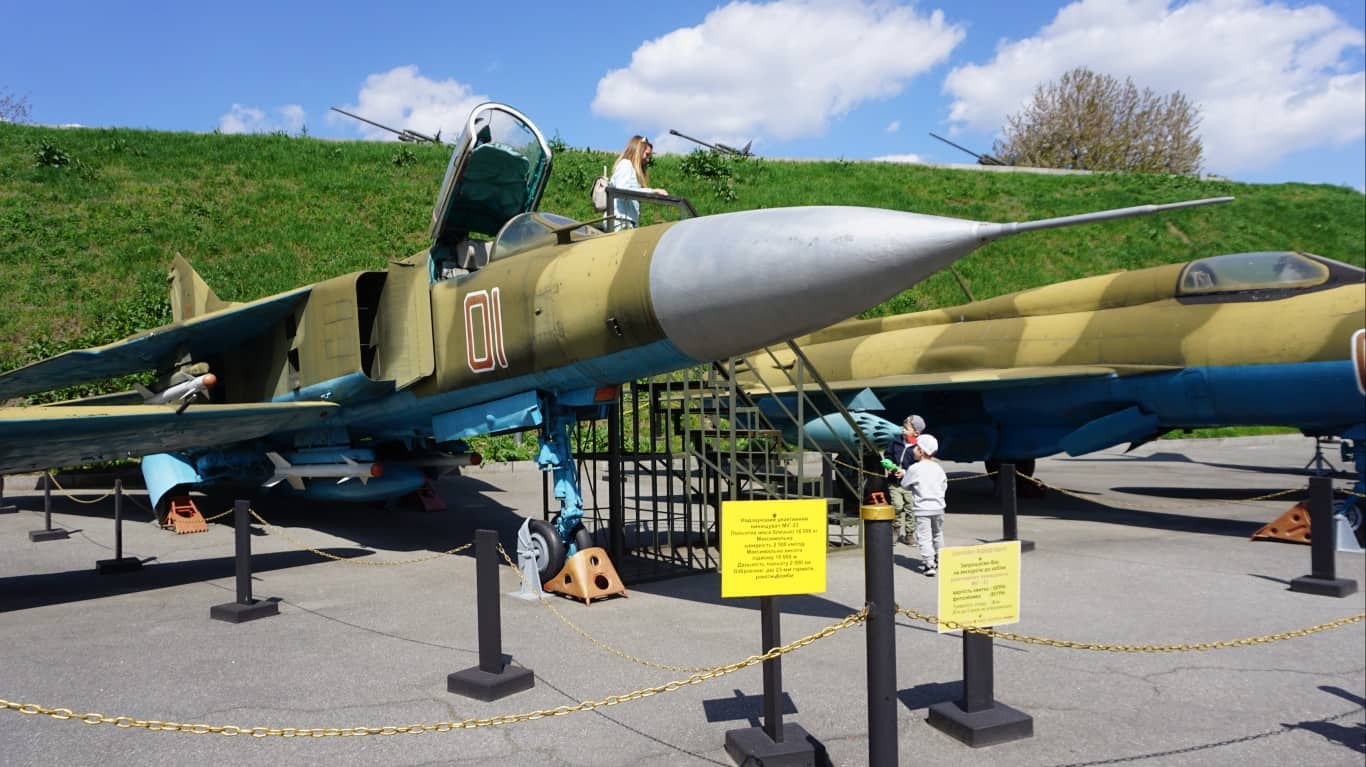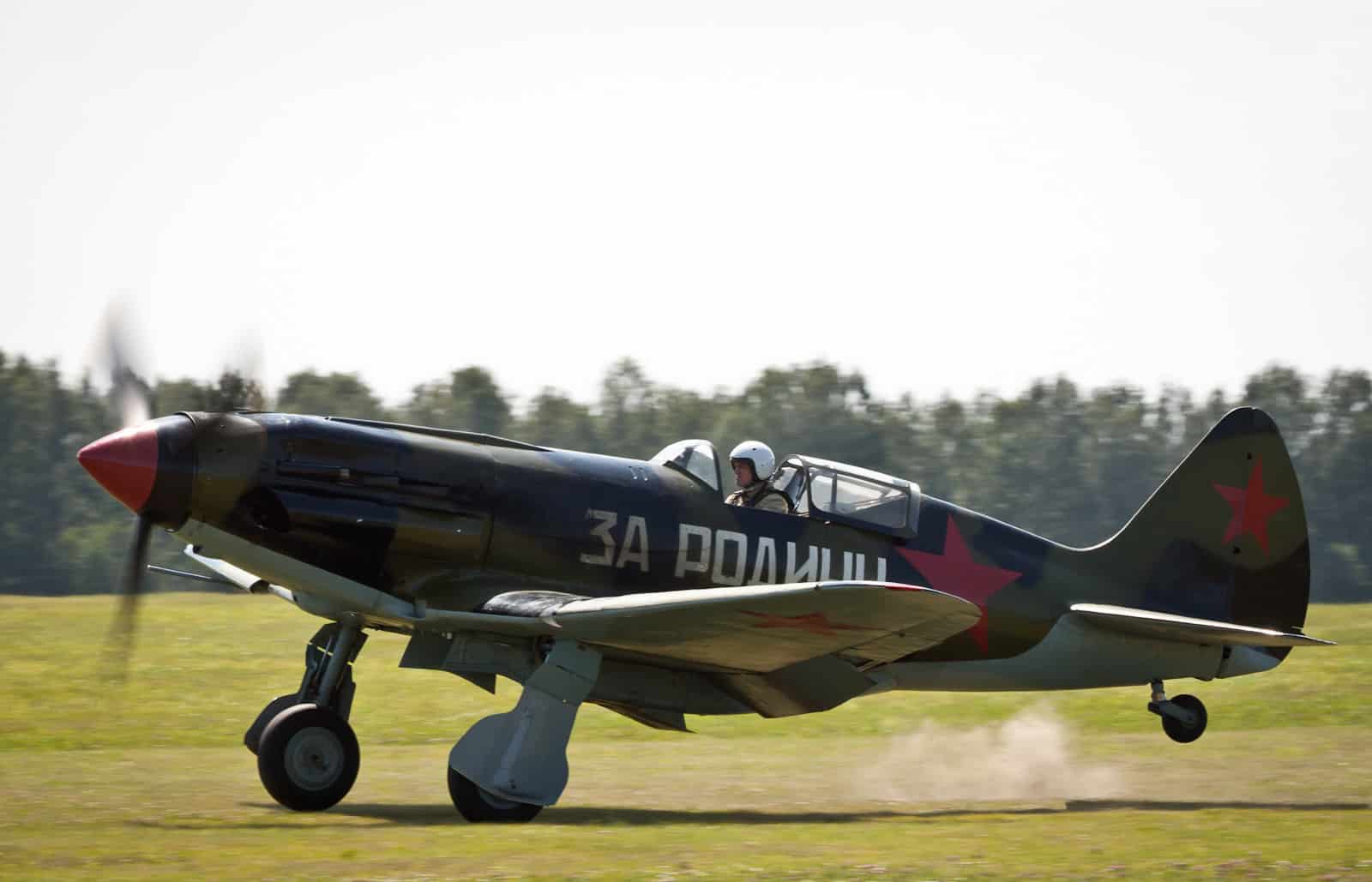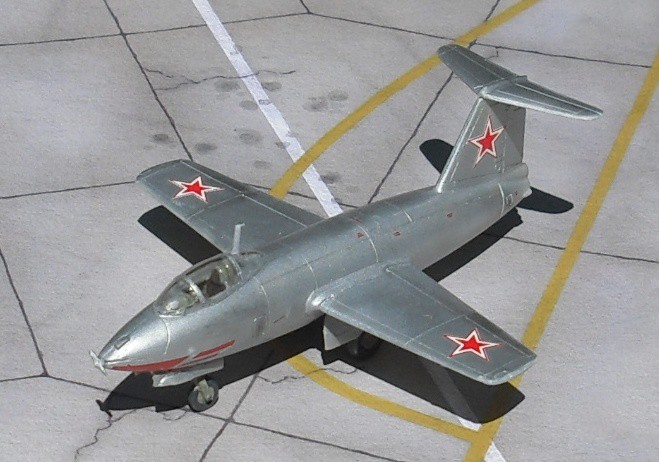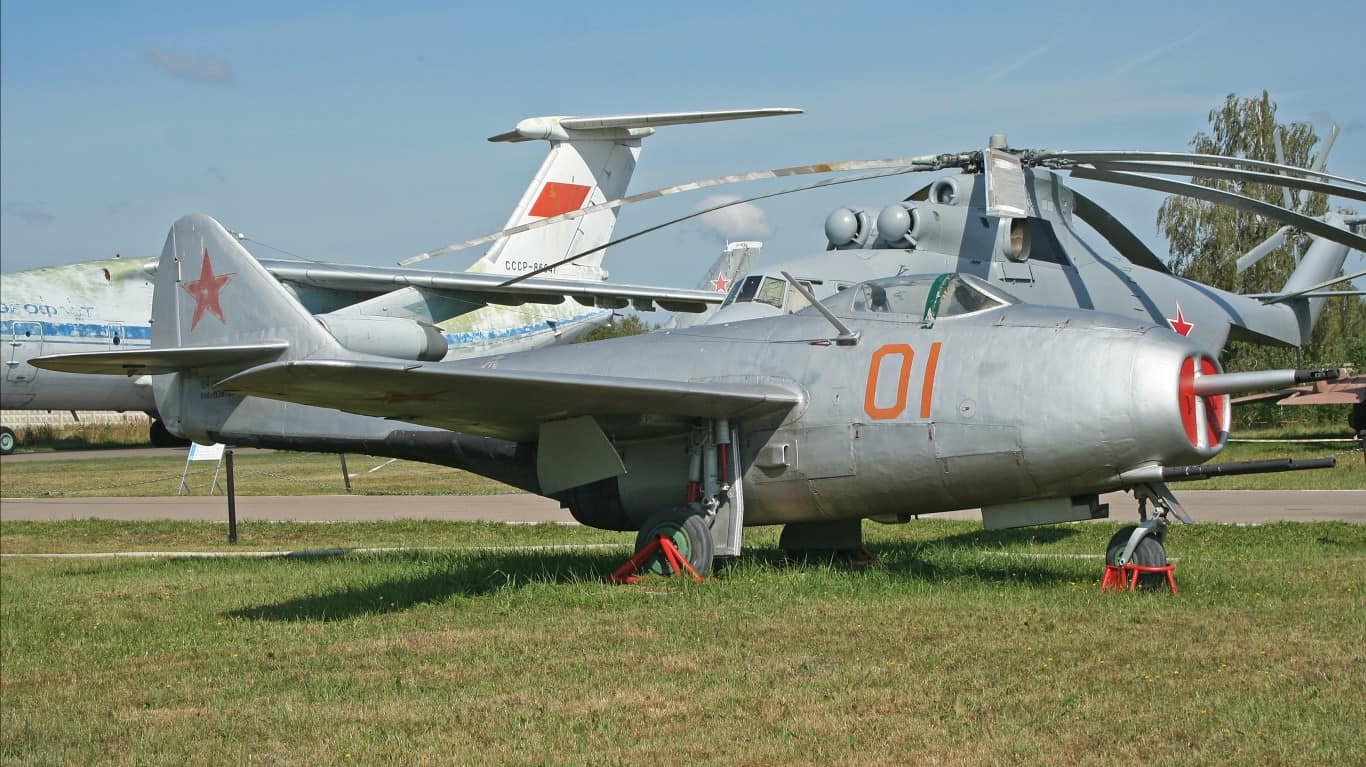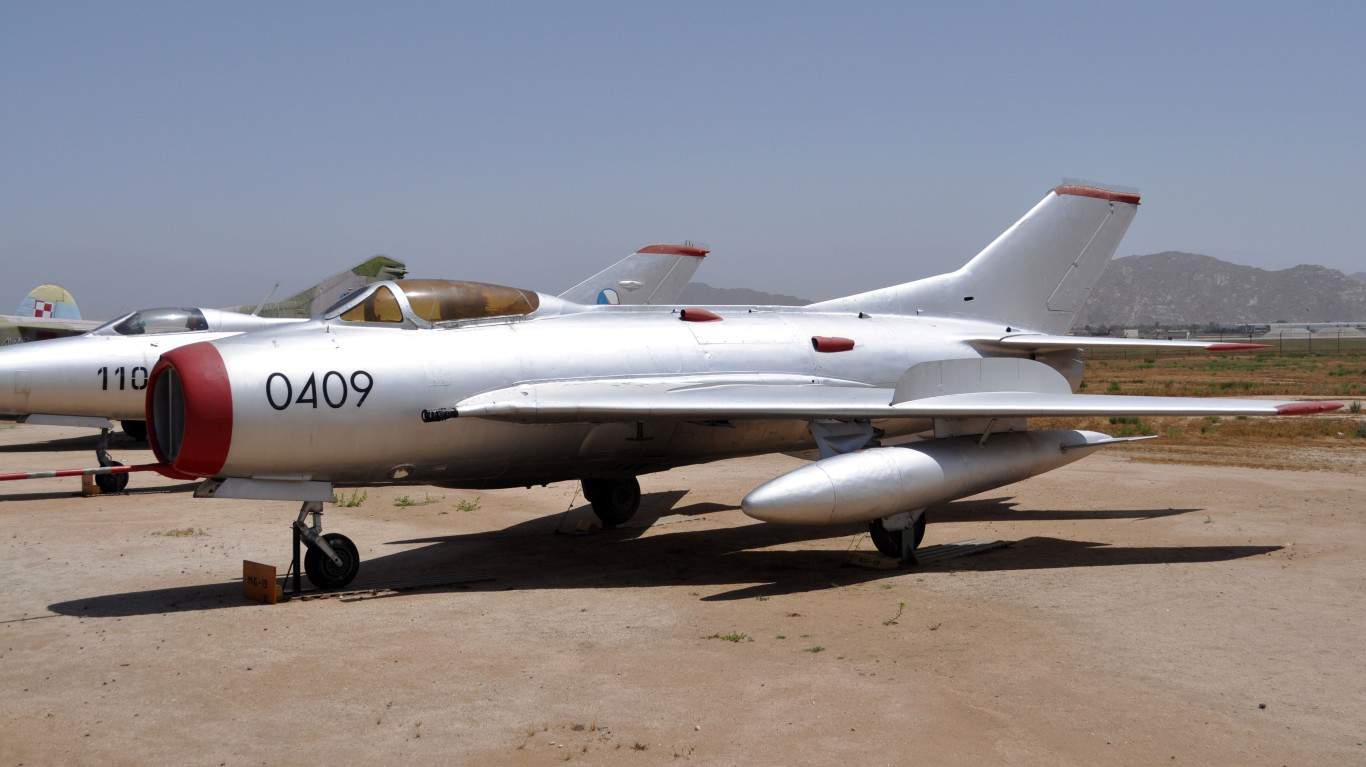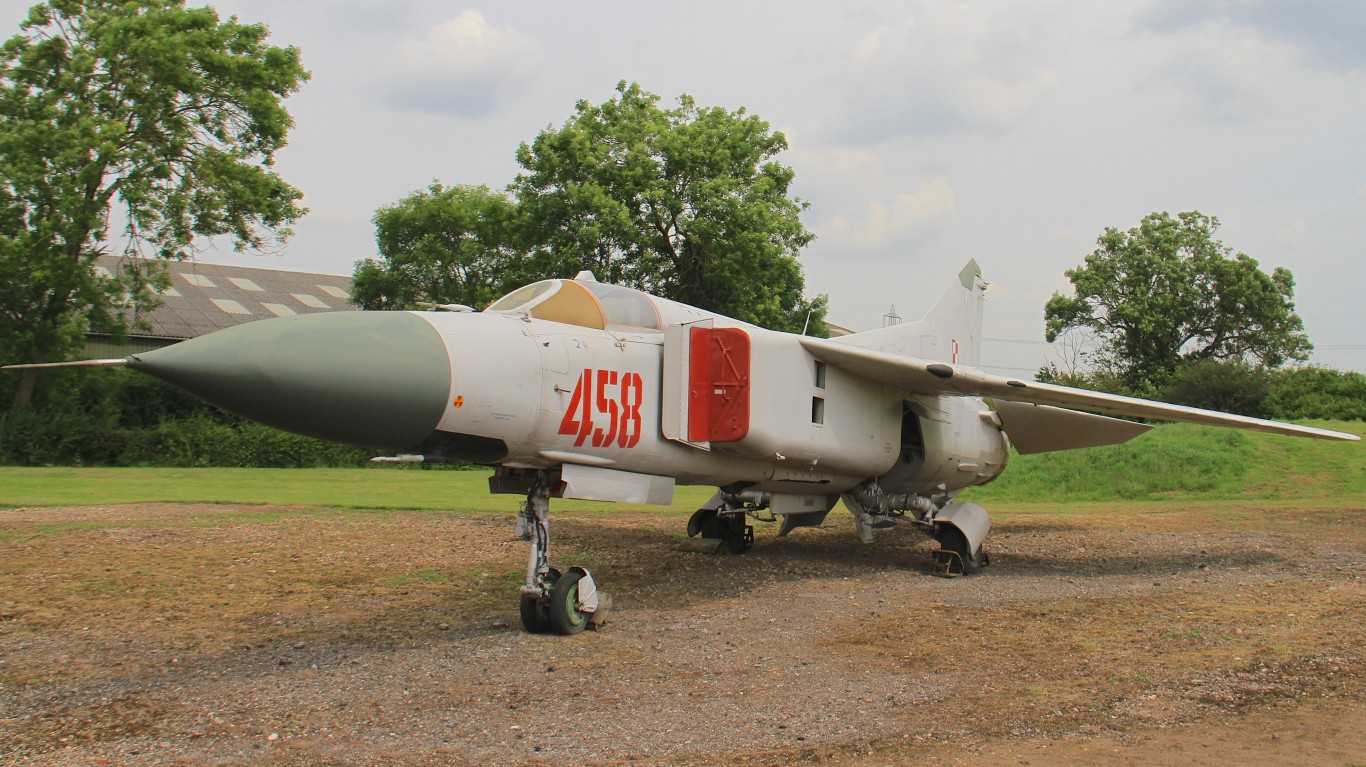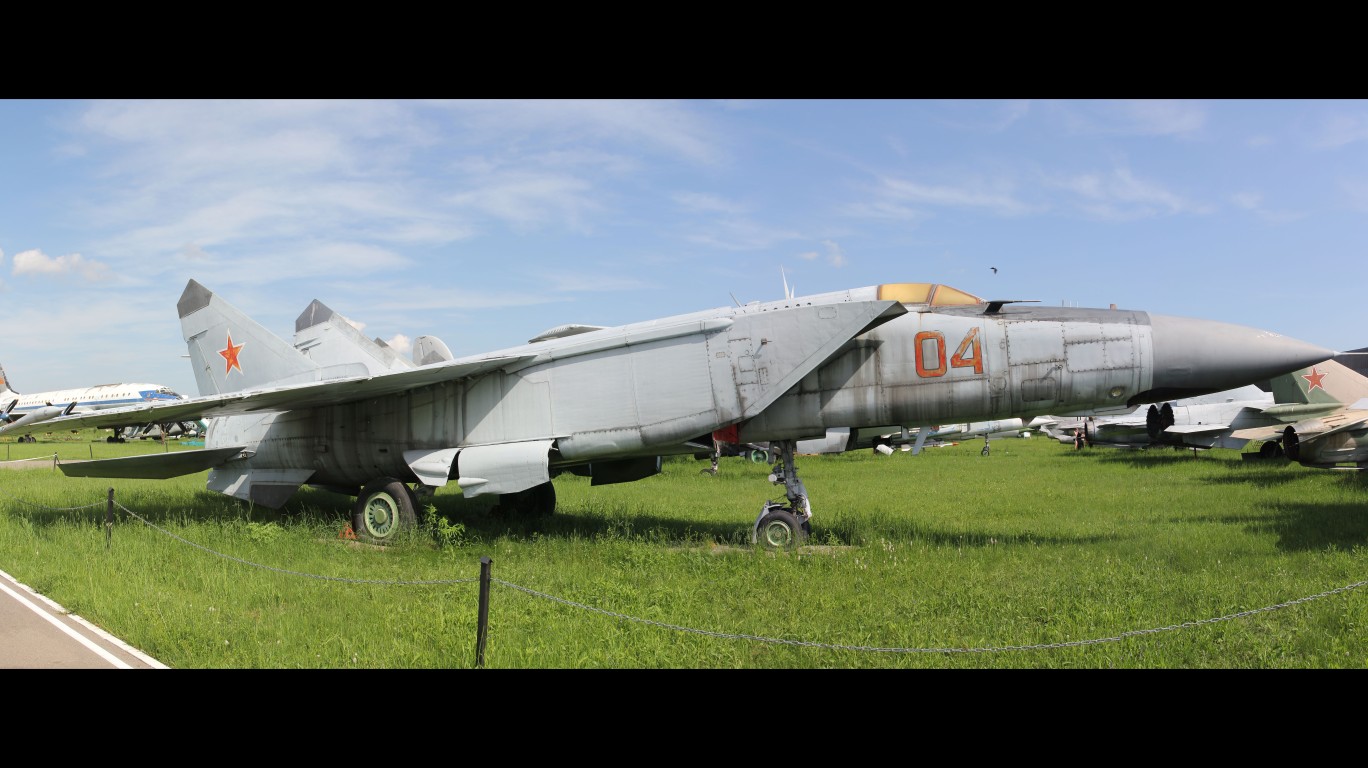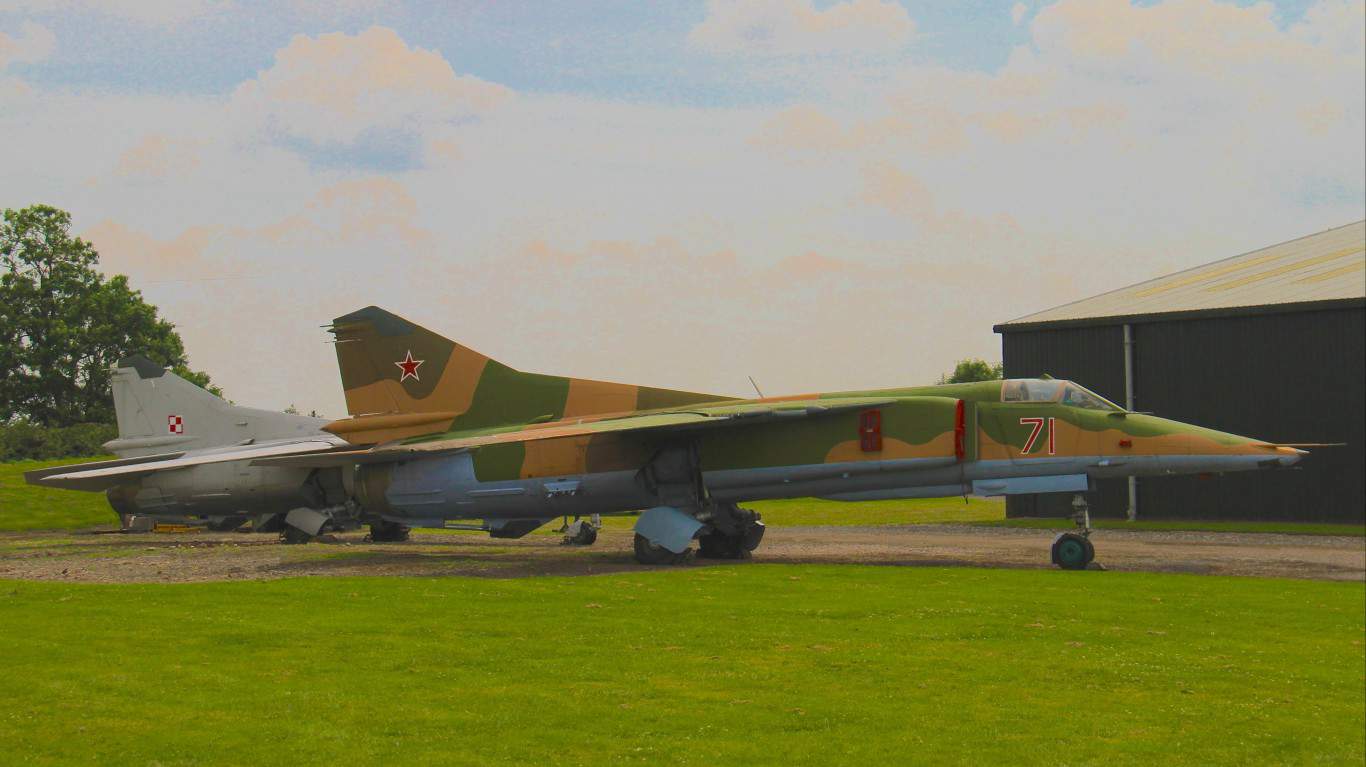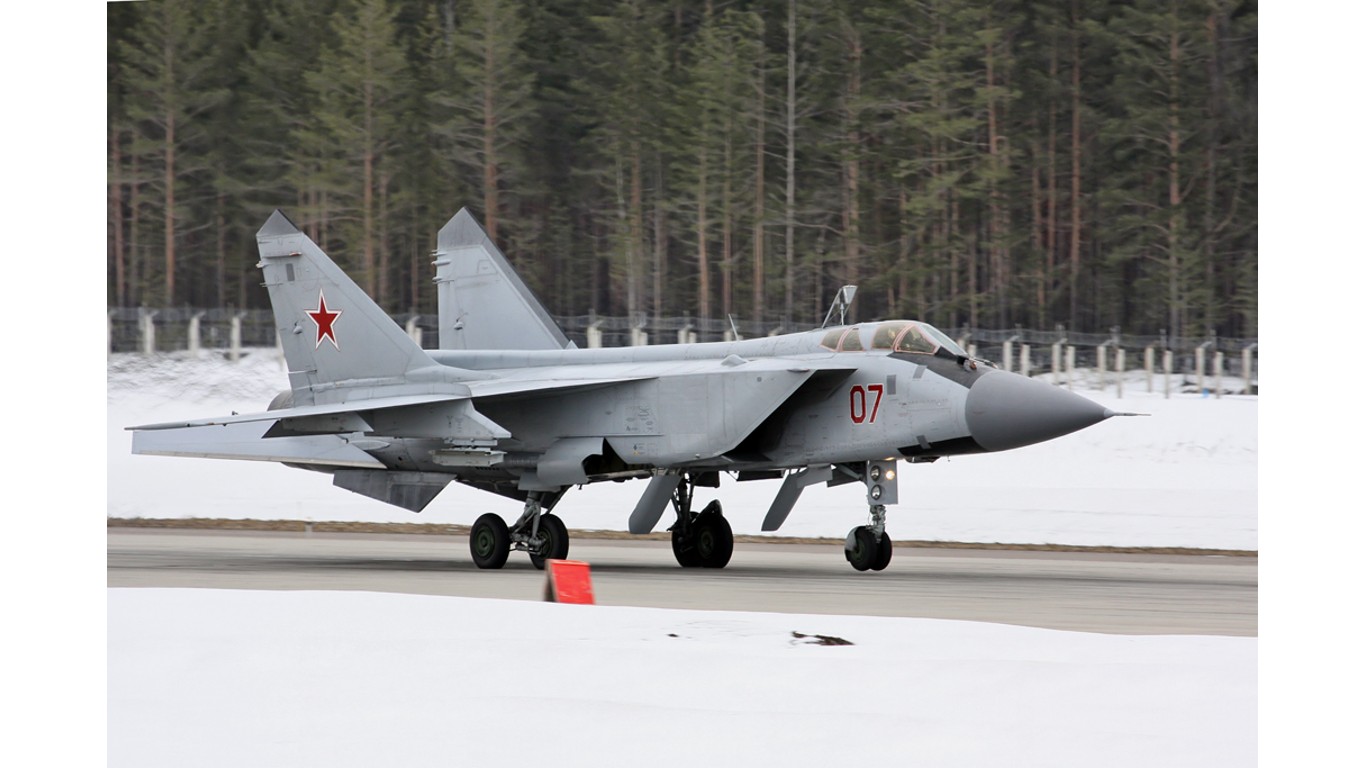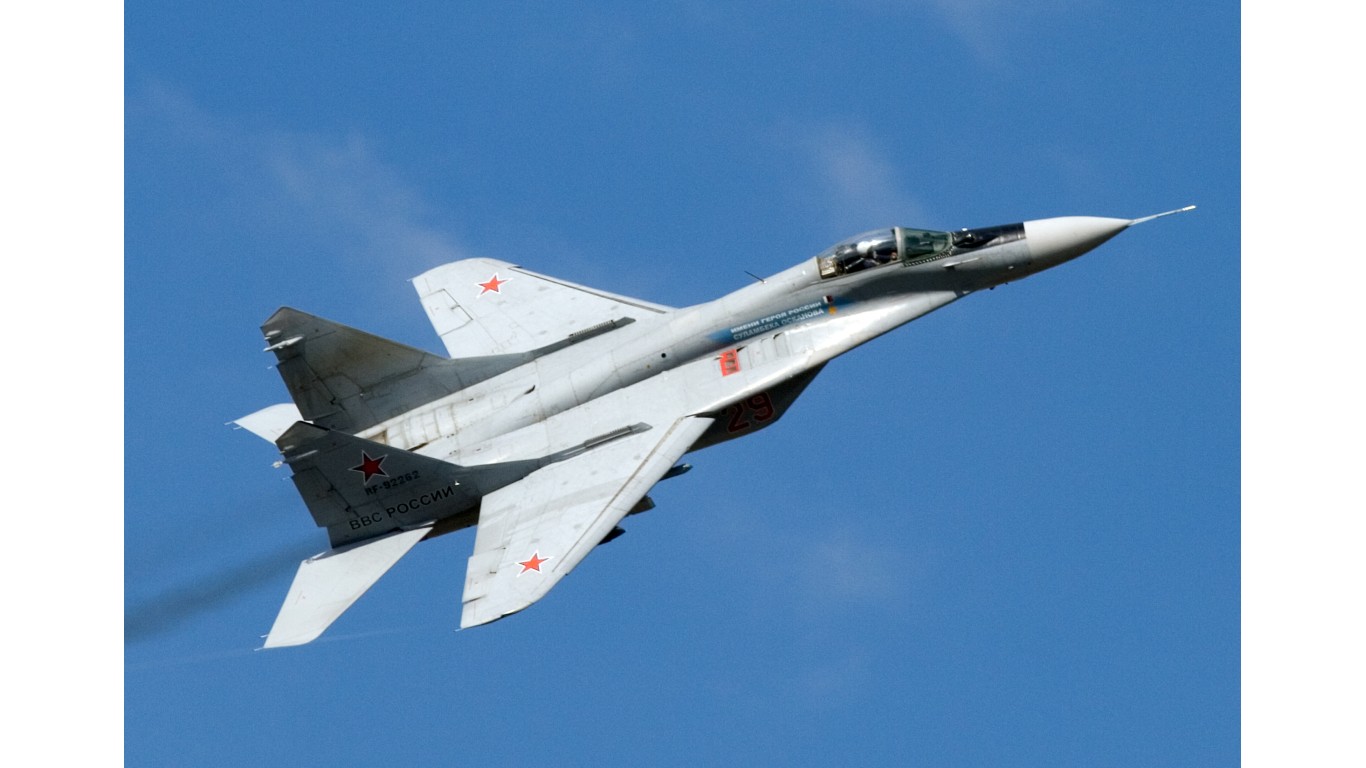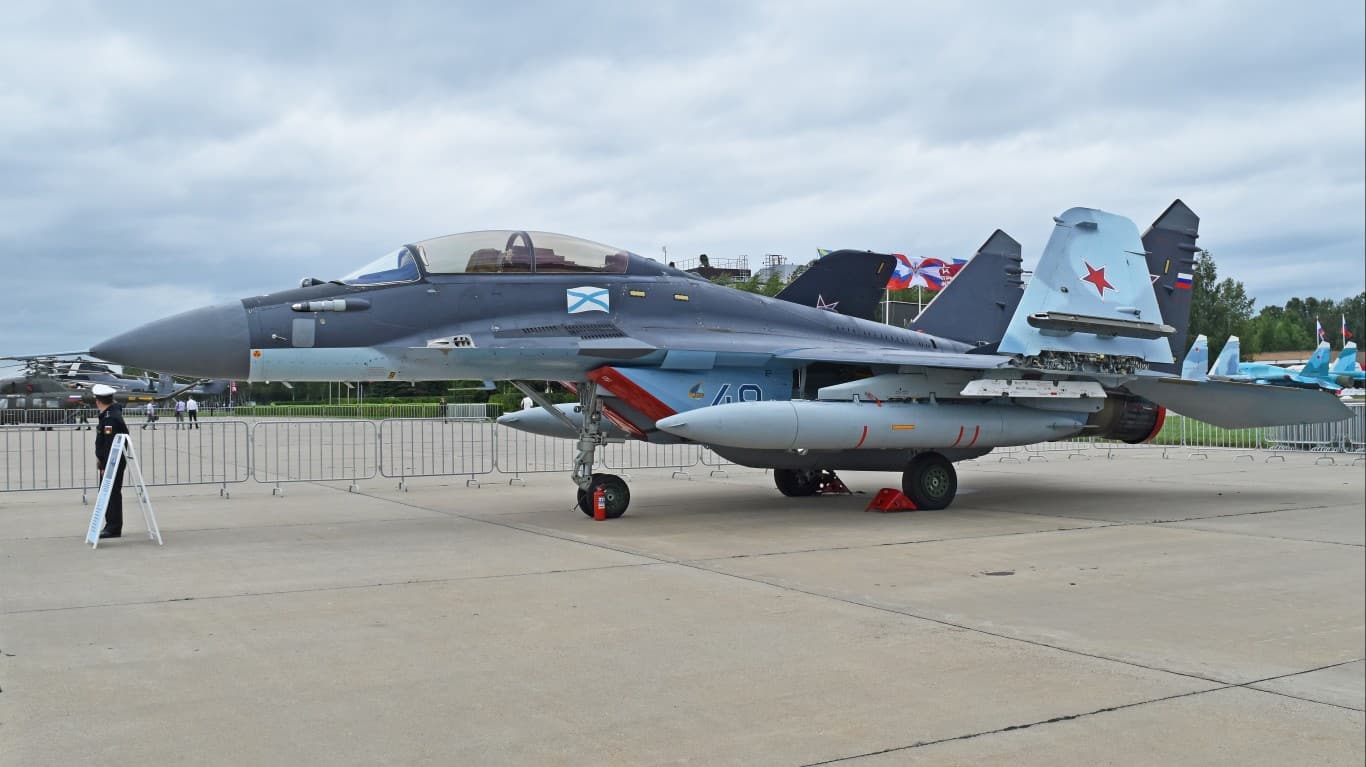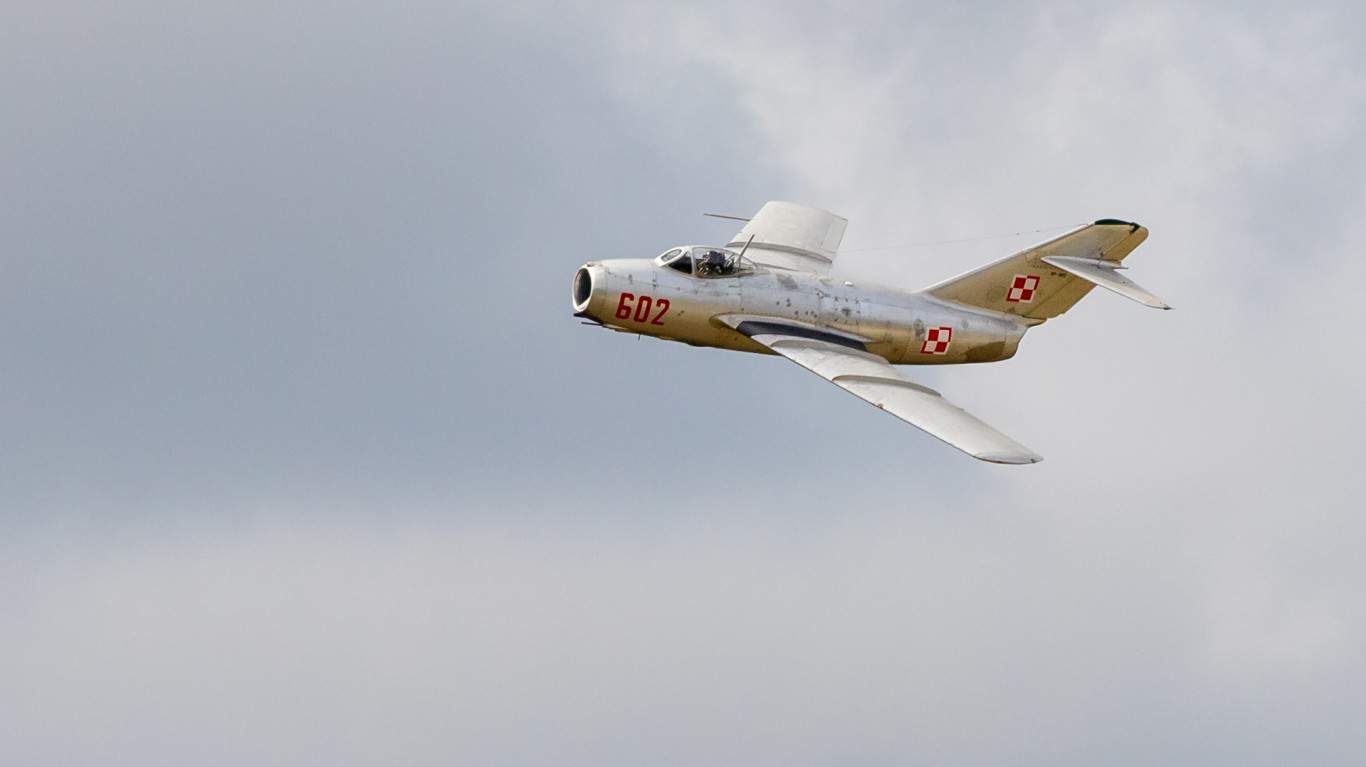
Over the course of the past century, many conflicts have been decided by one side maintaining air superiority. Historically, the United States has produced many of the aircraft that have controlled the skies in many of these conflicts, but there are other nations with comparable aircraft. Russia has produced a series of fighter jets for more than half a century that are some of the most iconic and lethal in the world, the MiGs.
Aerospace defense company Mikoyan-Gurevich Design Bureau, which was founded in 1939, produces the MiGs. Since the World War II era, the company has reinvented itself to currently be known as Russian Aircraft Corporation. However, the company still produces some of its aircraft from the past. (These are the 42 most popular fighter jets used in today’s air forces.)
To identify the most iconic MiG jets throughout history, 24/7 Wall St. reviewed a catalog of Russian aircraft from Military Factory, an online database of arms, vehicles, and aircraft used by militaries worldwide. We ordered these aircraft chronologically and added supplemental information from Military Factory regarding type of aircraft, year introduced, top speed, and armament.
The MiG-35 (Fulcrum-F) is the newest model to be released. First introduced in 2020, the most recent iteration of the Fulcrum series comes with improved radar, wings, and stealth capabilities. Although the MiG-35 is not considered a fifth generation aircraft, it has some of the generation’s technological features. (These are the most widely used stealth planes.)
The next generation of MiG is expected to be the MiG-41. This is still in the design and planning phase with an introduction expected as early as 2028.
Here is a look at the most iconic MiG jets throughout history:
MiG-5
- Type: Heavy fighter aircraft
- Year introduced: 1940
- Top speed: 379 mph
- Armament: 23mm VYa cannon, 12.7mm heavy machine guns, 7.62mm machine guns, conventional drop bombs, torpedoes
The MiG-5 was the first aircraft Miyokan-Gurevich introduced. While only two were actually produced, the family of MiG aircraft would go on to become a staple of the Soviet and Russian air forces as well as many other militaries around the world.
MiG-1 / MiG-3
- Type: Single-seat monoplane fighter aircraft
- Year introduced: 1941
- Top speed: 398 mph
- Armament: 12.7mm Beresin machine gun, 7.62mm ShKAS machine guns, rockets, drop bombs
Only about 100 MiG-1 models were produced, giving way to the MiG-3 model. Each model was developed early in WWII as a single-engine monoplane fighter, building on earlier prototypes. In all, over 3,400 MiG-3s were produced. Although these aircraft were not widely successful, they would set a precedent for Russian aircraft for decades to come.
I-270
- Type: Rocket-powered interceptor
- Year introduced: 1946
- Top speed: 581 mph
- Armament: 23mm Nudelman-Suranov automatic cannons
The I-270 was influenced by the German Messerschmitt Me 263 as a rocket-powered interceptor. These aircraft were outfitted with the Dushkin-Glushko RD-2 M3-V series rocket engine, which allowed for speeds over 580 mph. However, initial tests for this aircraft were burdened by setbacks that ultimately scuttled the program. The turbojet and missile technologies used in this aircraft would be used in other Soviet aircraft.
MiG-9 (Fargo)
- Type: Jet-powered fighter
- Year introduced: 1946
- Top speed: 566 mph
- Armament: 37mm cannon, 23mm cannons
The MiG-9 (Fargo) appeared immediately after WWII, using technologies that many speculate were from captured German aircraft. Nearly 600 models of this aircraft were produced. Setbacks and design flaws of this early jet were ironed out in later iterations of the MiG.
MiG-15 (Fagot)
- Type: Fighter aircraft
- Year introduced: 1949
- Top speed: 668 mph
- Armament: N-37 cannon, NR-23 cannons, conventional drop bombs, rocket pods
The MiG-15 (Fagot) was by far the most successful of the early MiG models with roughly 18,000 manufactured over the course of its service. It would see extensive combat action throughout the Korean War. Part of the reason for this aircraft’s success and popularity was its standard armament featuring a cannon (compared to smaller Western machine guns), which was capable of rendering enemy aircraft inoperable with just a single hit.
MiG-17 (Fresco)
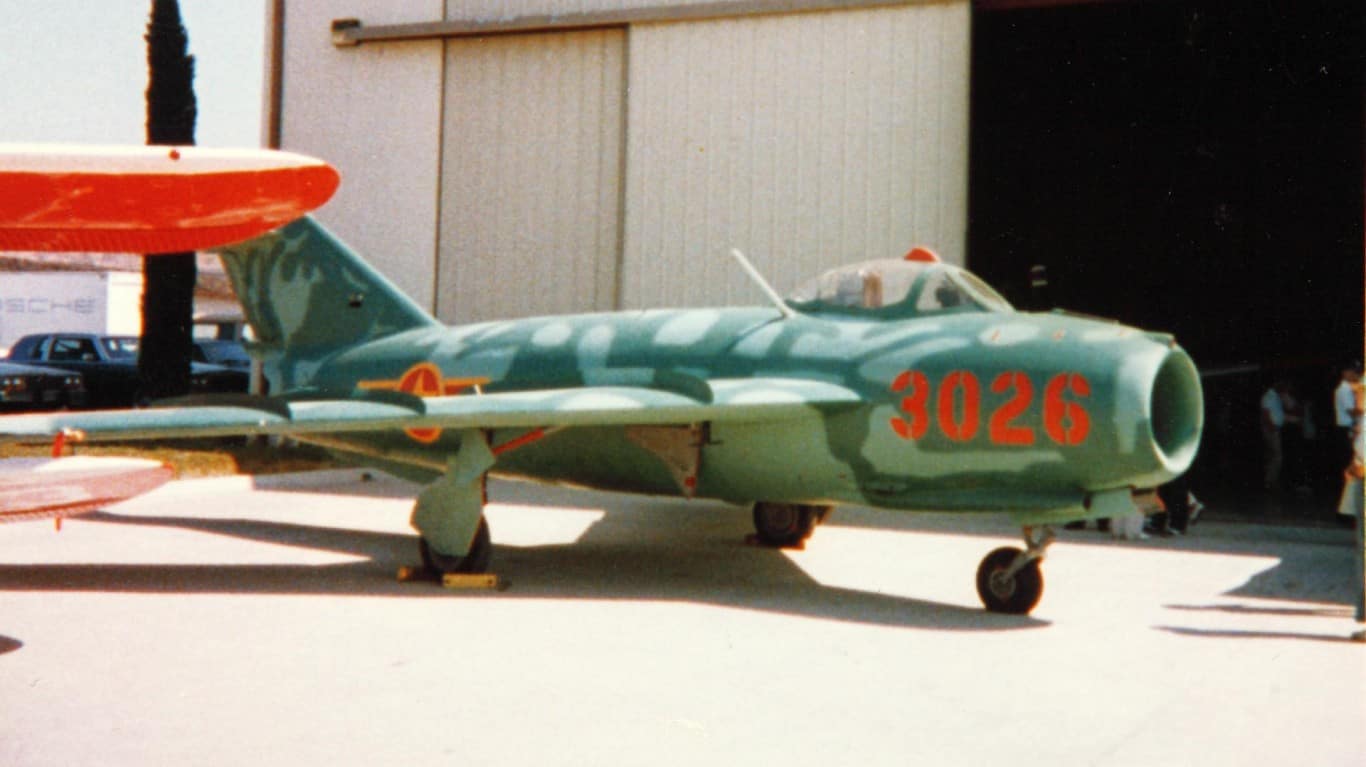
- Type: Fighter-bomber aircraft
- Year introduced: 1952
- Top speed: 684 mph
- Armament: 37mm internal automatic cannon, Alkali air-to-air missiles, conventional drop bombs, rocket pods
The MiG-17 (Fresco) was a vastly upgraded version of the MiG-15. Russian engineers improved on the handling and overall structure of the MiG-15, adding a bigger cannon as well. Overall, the MiG-17 is considered one of the best fighter jets of the Cold War. In fact, the United States had such a poor kill ratio against the MiG-17 during the Vietnam War that it secretly imported MiG-17s to Nevada to train against its weapons systems.
MiG-19 (Farmer)
- Type: Supersonic interceptor aircraft
- Year introduced: 1955
- Top speed: 902 mph
- Armament: 30mm NR-30 automatic cannons, rocket pods, air-to-air missiles, conventional drop bombs
The MiG-19 (Farmer) continued to build on the tech of the MiG-15 and MiG-17, this time with a twin-engine design that allowed it to hit speeds over Mach 1. It was the first Soviet fighter jet to fly at these speeds consistently in level flight. The Farmer was extensively modified, with variants playing a number of operational roles, including interception, air-to-air combat, ground attack, close-air support, and reconnaissance.
MiG-21 (Fishbed)
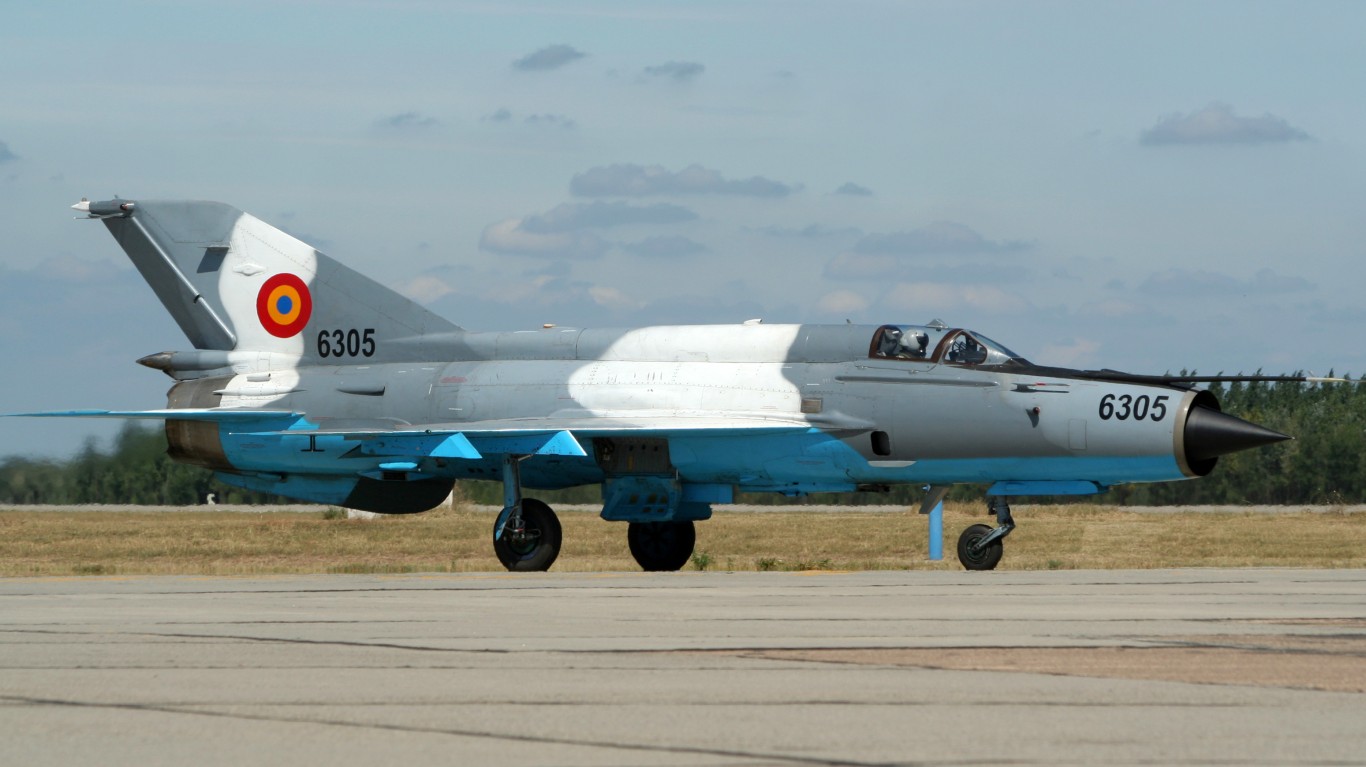
- Type: Supersonic fighter aircraft
- Year introduced: 1959
- Top speed: 1,386 mph
- Armament: 23mm GSh-23 automatic cannon, Molniya missiles, drop bombs
The MiG-21 (Fishbed) is one of the most successful Cold War fighter jets that the Soviets have introduced. It is still used in over 15 different air forces, and over 11,000 of these aircraft have been produced. The Fishbed built on the success and winning technologies of its predecessors in the Korean War and would go on to dominate in the Vietnam War where it faced off against the U.S. F-4 Phantom.
MiG-23 (Flogger)
- Type: Swing-wing fighter-interceptor aircraft
- Year introduced: 1970
- Top speed: 1,553 mph
- Armament: 23mm GSh-23L cannon, air-to-air missiles, air-to-surface missiles, rocket pods, drop bombs
The MiG-23 (Flogger) was a crucial part of the Soviet Air Force throughout the 1970s and early 1980s. Not only could this fighter-bomber aircraft reach speeds of Mach 2, but it also had the potential to carry nuclear-tipped weapons. It served primarily in an interceptor role.
MiG-25 (Foxbat)
- Type: Supersonic interceptor / reconnaissance bomber aircraft
- Year introduced: 1972
- Top speed: 2,156 mph
- Armament: Acrid missiles, Apex missiles, Aphid missiles, Archer missiles, Kilter missiles
The MiG-25 (Foxbat) is a highly specialized aircraft capable of almost Mach 3. Despite its incredible speed, the Soviet Union primarily used it for interception, bombing, and reconnaissance. The United States was able to secure one MiG-25 when Soviet pilot Viktor Belenko defected in 1976. However, with this jet Belenko, brought news that a new MiG-31 series was on the way with even more capabilities than previously thought.
MiG-27 (Flogger)
- Type: Swing-wing ground attack aircraft
- Year introduced: 1975
- Top speed: 1,171 mph
- Armament: 30mm GSh-6-30 Gatling style gun, air-to-air missiles, air-to-surface missiles, rocket pods, gun pods, drop bombs
The MiG-27 (Flogger) built on the MiG-23 but was more dedicated to ground attack aircraft. Despite technological upgrades, the previous Flogger model (MiG-23) was more popular and widely produced. Much of this decision by the Soviets to move away from the MiG-27 was that other aircraft within the Soviet air force, namely the Sukhoi Su-25, already filled the role of a proficient strike aircraft.
MiG-31 (Foxhound)
- Type: High-speed interceptor aircraft
- Year introduced: 1979
- Top speed: 1,864 mph
- Armament: 23mm GSh-6-23 internal cannon, Amos missiles, Aphid missiles, Acrid missiles
Although the MiG-31 (Foxhound) was introduced at the end of the 1970s, it is still in service today. It was developed in tandem with the Foxbat, but while it did not have the same speed capabilities, it offered much more maneuverability and control, especially at lower altitudes. These aircraft feature a similar arsenal of missiles as well.
MiG-29 (Fulcrum)
- Type: Multirole fighter aircraft
- Year introduced: 1984
- Top speed: 1,519 mph
- Armament: 30mm GSh-30 automatic cannon, Alamo missiles, Adder missiles, various air-to-air missiles, rocket pods, guided bombs
The MiG-29 (Fulcrum) laid the foundation for the newest MiGs to enter the Russian fleet of fighter jets. Although it was developed during the Soviet Union, the MiG-29 would continue to be a staple for Russia’s air force through numerous variations. Russia currently maintains over 200 of these fighter jets.
MiG-29K (Fulcrum-D)
- Type: Carrier-based multirole fighter
- Year introduced: 2009
- Top speed: 1,367 mph
- Armament: 30mm GSh-30 internal cannon, air-to-air missiles, air-to-surface missiles, anti-ship missiles, guided bombs, rocket pods
The MiG-29K (Fulcrum-D) is the navalised version of the traditional MiG-29. These are widely used by the Russian and Indian navies, as their compact size allows for easy storage and launch from aircraft carriers. These MiGs are designed with a reinforced undercarriage and folding wings for this purpose. However, only a handful of these aircraft were produced.
MiG-35 (Fulcrum-F)
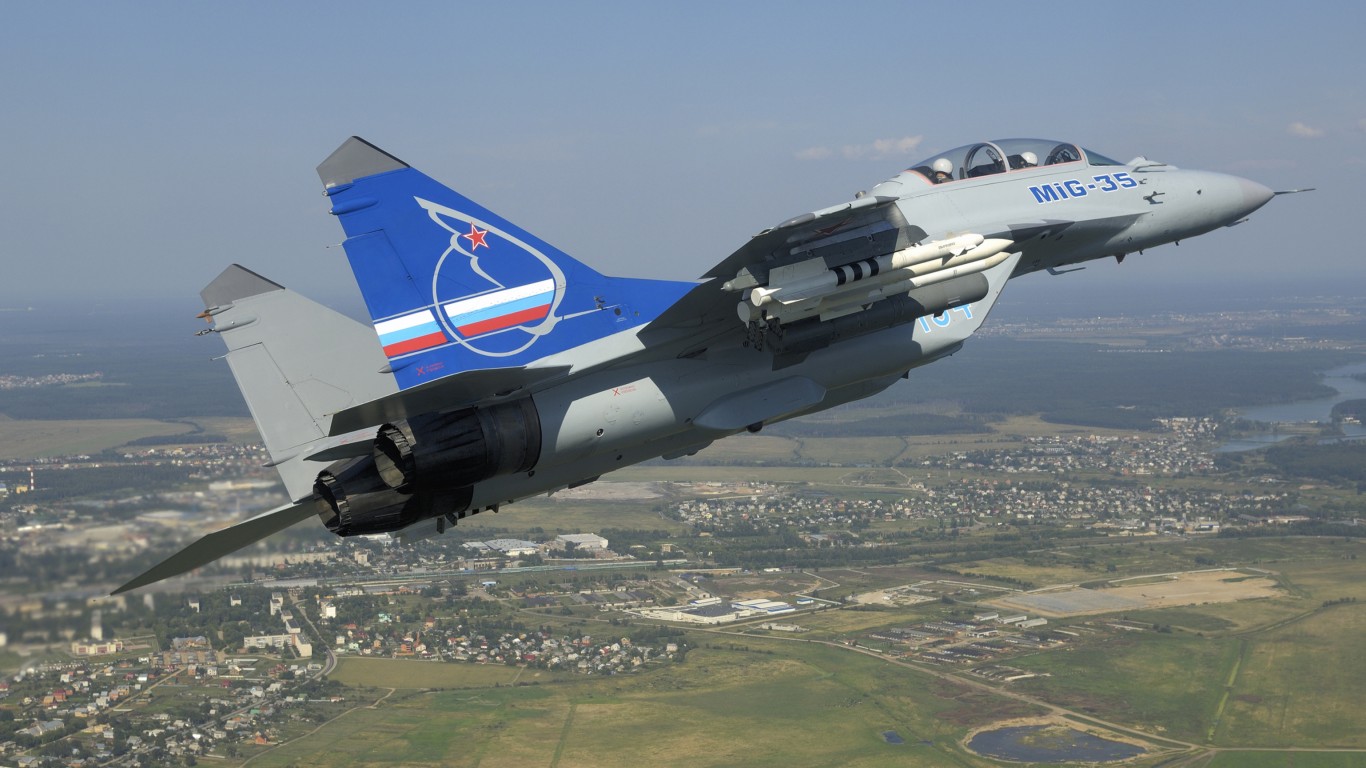
- Type: Multirole fighter aircraft
- Year introduced: 2020
- Top speed: 1,491 mph
- Armament: 30mm GSh-30 automatic cannon, Alamo missiles, Aphid missiles, Archer missiles, Adder missiles, Krypton missiles, guided bombs
The MiG-35 (Fulcrum-F) is the most recent iteration of the Fulcrum series, introduced to service in 2020. It features improved radar, wings, and stealth capabilities. Although the MiG-35 is not considered a fifth generation aircraft, it has some of the generation’s technological features as well as the improved control and handling that comes with each new generation.
It’s Your Money, Your Future—Own It (sponsor)
Are you ahead, or behind on retirement? For families with more than $500,000 saved for retirement, finding a financial advisor who puts your interest first can be the difference, and today it’s easier than ever. SmartAsset’s free tool matches you with up to three fiduciary financial advisors who serve your area in minutes. Each advisor has been carefully vetted and must act in your best interests. Start your search now.
If you’ve saved and built a substantial nest egg for you and your family, don’t delay; get started right here and help your retirement dreams become a retirement reality.
Thank you for reading! Have some feedback for us?
Contact the 24/7 Wall St. editorial team.
